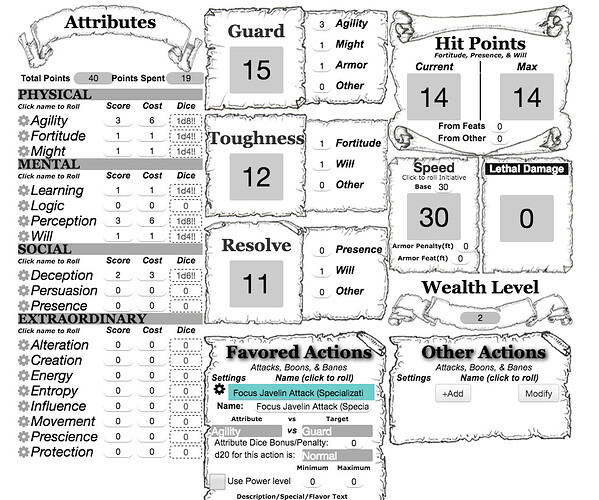Although most people will probably lament me trying to convert anything from 5E, but I do like being able to quickly create monsters that are cookie cutter, and not have to re-level something just for the right party level difficulty.
That being said. I have been toiling over the idea of taking old DnD monsters and common tropey types that will most likely be in a source book or source online, and converting them to OL. Now this isnt as easy as it may seem. Dnd already makes it difficult by rating monsters in 2 ways. OL does it easily and simply, but the common monsters in 5e are substanially easier to kill for an OL PC, just on the way the rules are stated.
In DnD, 1 single CR 1 Monster is a medium encounter for 4 players all level 1.
In Open Lenged , if all things equal as far the monster is concerned, you would have to make that same monster level 4, for that same group of level one PC’s a medium encounter at level 1.
I am wondering how the monster guide will be, if technically you could make any monster any level, but I am guessing that DM’s will have certain monsters set at certain levels, for easy duplication.
Do you give the monsters a range of levels?
Do you just give them a max level?
Can you give them just one level, and the try to balance all other known monsters to be increasingly more/less difficult?
Do I make a Giant wolf in Open Legend a level 4 monster, so that 4 level 1 PC’s are at least a little stressed about the Dire Wolf that could kill someone?
Has anyone tried converting monster manual monsters to OL yet?
If I just multiply by 4, its skips the odd levels all together, and makes monsters way higher level for solo encounters.
Please give me your input. I love fantasy campaigns, and I like some of the older ones from DnD. I just want to convert them to OL, becuase I really love this system.
Going from 20 levels to 10, and cramming everything we are used to fighting in that range is really hard.
Does that mean in Open Legend , monsters will be rated 0(minion) to 40 ?
That would mean that anything over 30 is impossible to kill for only 3 players.
Does that mean that Bosses are the only thing that can be rated above Level 10 as a single encounter?
If you totally avoid the whole copying DnD thing, you still have to wonder how you can even make a monster guide book if each monster you put in it is not a static level.
Making character sheets in Roll 20 for every monster is painful, especially if I have to make a new one for every other goblin or humanoid that could be different, just for each encounter you might have.
Right now i have a spreadsheet so compare ratings. Mostly because I wanted to make Random Encounter tables, I love having encounters at inopportune times if the players dilly dally too long.
Well for the sake of balance, I need cookie cutter monsters for that. Not hand made on the fly ones.
Right now for the example above, I have a Dire wolf being Level 2 straight up.
That way the same encounter mentioned is a 4 levels encounter and the 4 level ones dont have to each solo a Giant wolf on their own.
Any input is helpful.
Thanks,
Sooner

 will share when I’m done.
will share when I’m done.